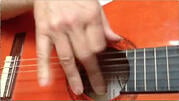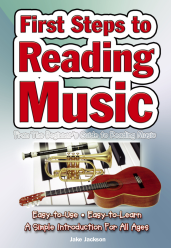 Good strumming is a core skill for every guitarist, especially the acoustic specialist. Most people start with simple strokes up and down, so its worth refining your methods as soon as possible: it's all too easy to slip into bad habits! One of the great things about the guitar is that you can make a good sound very quickly with very little knowledge of chords, and no interest in notation: strumming will allow you to get to grips with the songs you like, or make up your own.
Good strumming is a core skill for every guitarist, especially the acoustic specialist. Most people start with simple strokes up and down, so its worth refining your methods as soon as possible: it's all too easy to slip into bad habits! One of the great things about the guitar is that you can make a good sound very quickly with very little knowledge of chords, and no interest in notation: strumming will allow you to get to grips with the songs you like, or make up your own.
Strumming is one of the early steps in learning to play the guitar. This post is a companion to the strumming technique pages (Step 2, page 46 if you must know) in Play the Guitar Made Easy, link here). You can also use our music website to hear chords and scales.
These short videos use a medium body Morris acoustic guitar, which has Fishman pick-up for live gigs. It's a robust guitar, it combines bright tones with a warm, reflective character: like a mini Martin (I wish!).
Strumming Techniques 01: Right Hand Positions
This first video shows the sound of strumming the guitar at different places - at the bridge, at the end of the neck, over the sound hole, each producing different qualities of sound. Playing close to the bridge creates a tight, rockier feel, but over the neck the sound is blousier.
Strumming Techniques 02: Rocky Strokes (Bass Strings)
Strumming on the 6th and 5th bass strings, close to the bridge of the guitar, gives a nice rocky feel. Keep the wrist loose but hold the pick firm and try to avoid too much movement from the arm. This is a simple exercise based on G major, A minor and E major, played using barre chords (on the first two chords) to give a tight, solid sound.
Strumming Techniques 03: Upstrokes (Treble Strings)
Using up-strokes naturally strikes the trebles strings first to produce a clear, bright sound. This video plays the strokes slowly at first, then speeds up. Towards the end the edge of the palm is used to deaden the ring of the strings, creating a more percussive flow. The chords are all variations on D major.
This technique works well as a companion to lower notes sounded on another acoustic guitar, creating a wider harmonic base for melodic instruments or voices to move around.
Strumming Techniques 04: Full Strokes (All Strings)
There are three types of full stroke strumming here: slow, full chords; faster full chords; fast and percussive. The slower chords here ring out with a clear, natural reverb; the same chords played faster propel the song forward; the percussive final section allows for more complex rhythms, which would combine with other instruments, voices, or straightforward stamping of the feet! The chords here are C major, A minor and G major.
There's More to Strumming Than Meets the Ear!
An acoustic guitar can take the place of drums in a simple set-up, creating the engine room of a song. If more than one guitar is playing chords in the full-stroke style of strumming, one guitar should take the first position chords and the other use second or, preferably, third position to give some variety and width to the sound.
Links
- Our Flame Tree Music chord finder website with sounds for each note. Here. Also now, 20 scales for each key.
- Take a look at Flame Tree Rock for inspiration, mixtapes and free downloads.
- More video techniques here and here.

 This sort of rif can be played on any guitar: electric, acoustic steel, flamenco or classical nylon, as long as the instrument has some bounce in the strings (some of the cheapest guitars are so rigid it’s impossible to get a decent sound out of them). An electric rock guitarist might hold some of the notes longer, a folk guitarist might try to achieve a more staccato feel but a classical player might aim for greater tonal variation.
This sort of rif can be played on any guitar: electric, acoustic steel, flamenco or classical nylon, as long as the instrument has some bounce in the strings (some of the cheapest guitars are so rigid it’s impossible to get a decent sound out of them). An electric rock guitarist might hold some of the notes longer, a folk guitarist might try to achieve a more staccato feel but a classical player might aim for greater tonal variation. Over the next few months we’ll introduce a series of posts on guitar techniques, adding a further dimension to our extensive range of practical music books and our new chord and scales website, Flame Tree Music.
Over the next few months we’ll introduce a series of posts on guitar techniques, adding a further dimension to our extensive range of practical music books and our new chord and scales website, Flame Tree Music. It's worth spending five minutes a day on right hand techniques for a few weeks while you begin to explore the notes and strings. The next videos will focus on left hand techniques and introduce chords.
It's worth spending five minutes a day on right hand techniques for a few weeks while you begin to explore the notes and strings. The next videos will focus on left hand techniques and introduce chords.




